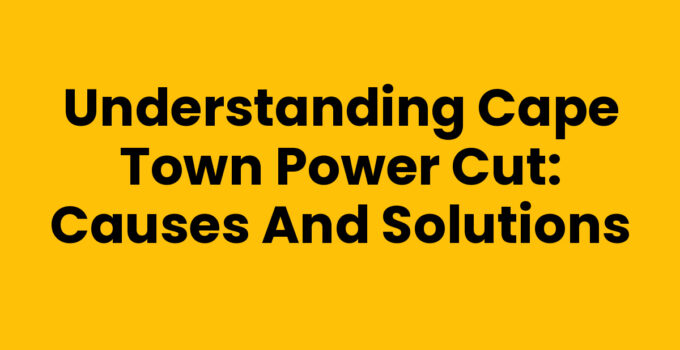Cape Town, a city known for its breathtaking landscapes and rich culture, has been facing a significant challenge in the form of power cuts. As these disruptions become more frequent, it is crucial for residents and visitors alike to understand the underlying causes, implications, and potential solutions. This guide aims to provide comprehensive insight into the Cape Town power cut situation.
What is a Cape Town Power Cut?
A Cape Town power cut refers to the interruption of electricity supply to various areas in Cape Town, typically caused by load shedding implemented by utility providers to prevent the entire grid from collapsing. Load shedding occurs when demand for electricity exceeds supply, prompting the utility to cut power to certain areas for a specific duration.
Recommended Reading: Explore Wonderland Cape Town: A Family-Friendly Adventure
Causes of Cape Town Power Cuts
The primary reasons behind the power cuts in Cape Town include:
- Insufficient Generation Capacity: The main utility provider, Eskom, often struggles to meet the high demand for electricity due to aging infrastructure and maintenance issues.
- Unplanned Maintenance: Emergency repairs on plants can lead to unexpected power reductions, impacting supply across the city.
- Weather Conditions: Adverse weather events, such as storms, can damage transmission lines and disrupt service.
- Increased Demand: Growing residential and industrial needs, especially during peak hours, exert additional pressure on the grid.
Recommended Reading: Sell Your Car Fast: Webuycars Brackenfell Cape Town Guide
How to Prepare for and Manage Cape Town Power Cuts
Being proactive can make coping with power cuts easier. Here are some practical steps to manage and prepare for these interruptions:
- Invest in Backup Power Solutions: Consider purchasing a generator or an uninterruptible power supply (UPS) system to keep essential devices running during outages.
- Stay Informed: Regularly check updates from Eskom and local news sources about scheduled power cuts to minimize disruption to your routine.
- Reduce Energy Consumption: Simple actions such as switching off unnecessary lights and devices can help reduce demand and ease the pressure on the grid.
- Create a Power Cut Kit: Keep essential items like flashlights, batteries, and non-perishable food stocked for emergencies.
- Community Engagement: Join local groups to discuss energy conservation methods or support community initiatives aimed at improving energy infrastructure.
The Impacts of Cape Town Power Cuts
Power cuts can have wide-ranging effects on both daily life and the local economy:
- Economic Disruptions: Businesses may suffer losses due to interrupted operations, which could lead to reduced productivity and job insecurity.
- Health Risks: Dependent medical devices may fail without power, putting vulnerable populations at risk.
- Impact on Education: School closures or disruptions can hinder the learning process for students.
- Safety Concerns: Power cuts increase the risk of crime as streetlights are out, making neighborhoods less safe.
Recommended Guide: Explore Saigon Cape Town: A Unique Cultural Journey
Conclusion
The Cape Town power cut situation requires ongoing attention and proactive measures from both residents and authorities. By understanding the causes, preparing adequately, and actively engaging with energy conservation efforts, the community can work together to mitigate the challenges posed by power interruptions.
Further Reading: Self Catering Accommodation In Bloubergstrand Cape Town
Frequently Asked Questions
What causes power cuts in Cape Town?
Power cuts in Cape Town are primarily caused by load shedding due to insufficient generation capacity, unplanned maintenance, weather conditions, and increased demand.
How long do power cuts usually last?
The duration of power cuts can vary, but they typically last from two to four hours, depending on the area and the scheduling by Eskom.
What can residents do to prepare for power cuts?
Residents can invest in backup power sources, stay informed about cut schedules, reduce energy consumption, and create emergency kits for preparedness.



